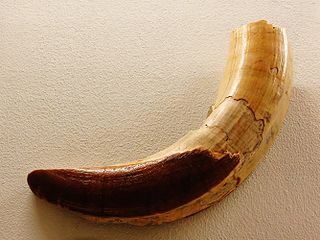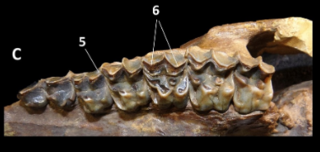
The falcons and caracaras are around 65 species of diurnal birds of prey that make up the family Falconidae. The family is divided into three subfamilies: Herpetotherinae, which includes the laughing falcon and forest falcons; Polyborinae, which includes the spot-winged falconet and the caracaras; and Falconinae, the falcons and kestrels (Falco) and falconets (Microhierax).

Theosodon is an extinct genus of litoptern mammal from the Early to Middle Miocene of South America.

Cramauchenia is an extinct genus of litoptern South American ungulate. Cramauchenia was named by Florentino Ameghino. The name has no literal translation. Instead, it is an anagram of the name of a related genus Macrauchenia. This genus was initially discovered in the Sarmiento Formation in the Chubut Province, in Argentina, and later it was found in the Chichinales Formation in the Río Negro Province and the Cerro Bandera Formation in Neuquén, also in Argentina, in sediments assigned to the SALMA Colhuehuapian, as well as the Agua de la Piedra Formation in Mendoza, in sediments dated to the Deseadan. In 1981 Soria made C. insolita a junior synonym of C. normalis. A specimen of C. normalis was described in 2010 from Cabeza Blanca in the Sarmiento Formation, in sediments assigned to the Deseadan SALMA.

The Eocardiidae are an extinct family of caviomorph rodents from South America. The family is probably ancestral to the living family Caviidae, which includes cavies, maras, and capybaras and their relatives. McKenna and Bell (1997) divided eocardiids into two subfamilies, Luantinae for two of the oldest genera and Eocardiinae for remaining genera. Kramarz (2006) has recommended the abandonment of these subfamilies, as the genera placed in Luantinae appear to represent basal eocardiids, rather than a specialized side branch. The latter hypothesis had been proposed by Wood and Patterson (1959).
The Neoepiblemidae are an extinct family of hystricognath rodents from South America. The genera Dabbenea and Perumys are now included in Phoberomys. The delineation between Neoepiblemidae and Dinomyidae has historically been unclear, with some genera having varying taxonomic placement. A 2017 study found Phoberomys to be part of the group, while Eusigmomys was found to be part of the Dinomyidae.

Astrapotheriidae is an extinct family of herbivorous South American land mammals that lived from the Late Eocene to the Middle Miocene 37.71 to 15.98 million years ago. The most derived of the astrapotherians, they were also the largest and most specialized mammals in the Tertiary of South America. There are two sister taxa: Eoastrapostylopidae and Trigonostylopidae.
Comahuetherium is an extinct genus of astrapotherian mammal from the Early Miocene. It is a basal astrapotheriid which lived in what is now Patagonia, Argentina. The holotype was found in the Cerro Bandera Formation in Neuquén Province, northern Patagonia and additional specimens were found at the Gran Barranca south of Lake Colhué Huapi, in Chubut Province of central Patagonia. It was first named by Alejandro Kramarz and Mariano Bond in 2011 and the type species is Comahuetherium coccaorum.
Antarctodon is an extinct genus of mammals from the Early Eocene. It is a basal astrapotherian which lived in what is now Seymour Island, Antarctic Peninsula, at that moment still connected to South America where most of the astrapotherians were found. The holotype and only specimen MLP 08-XI-30-1, an isolated right p4 or m1, was found in the Telm 5 Member of the La Meseta Formation in West Antarctica. It was first named by Mariano Bond, Alejandro Kramarz, Ross D. E. MacPhee and Marcelo Reguero in 2011 and the type species is Antarctodon sobrali.

Parastrapotherium is an extinct genus of South American land mammal that existed from the Late Oligocene to the Early Miocene. The genus includes some of the largest and smallest known astrapotherian, but at present no generally recognized description can adequately characterize it.
Scaglia is an extinct genus of South American astrapotherid land mammal that lived during the Eocene.
Maddenia is an extinct genus of astrapothere, meridiungulate herbivore mammals characterised by its large tusks and the development of proboscis, endemic of South America. This genus was discovered in an outcrop near to the Lake Colhué Huapi in the place La Cantera, in the Chubut Province, in Argentina, in sediments corresponding to the Sarmiento Formation, that dates of the Late Oligocene.

Prohegetotherium is an extinct genus of hegetotheriid notoungulates from the Late Oligocene to Early Miocene of the Agua de la Piedra, Mariño & Sarmiento Formations of Argentina, the Petaca and Salla Formations of Bolivia, and Fray Bentos Formation of Uruguay.
Astrapothericulus is an extinct genus of mammals, belonging to the order Astrapotheria. It lived during the Lower Miocene in what is now South America.

Tetramerorhinus is an extinct genus of proterotheriid litoptern that lived during the Early and Middle Miocene in what is now Argentina and Peru.
Proadinotherium is an extinct genus of toxodontid. It lived between the Late Oligocene and the Early Miocene in what is now South America.
Lambdaconus is a genus of proterotheriid from the Late Oligocene to Early Miocene of Argentina. The type species is L. suinus, named in 1897 by Ameghino, with referred species including L. lacerum, named as Proterotherium lacerum in 1902 by Ameghino, and L. inaqeuifacies.

Paramacrauchenia is an extinct genus of proterotheriid litopterns from the Early Miocene of what is now Argentina and Chile. Its fossils have been found in the Sarmiento and Santa Cruz Formations of Argentina and Chile.
Hegetotheriopsis is an extinct genus of hegetotheriid notoungulate. It lived from the Late Oligocene to the Early Miocene, and its fossilized remains are found in Argentina.

Perimys is an extinct genus of neoepiblemid rodent that lived from the Early to Late Miocene in what is now South America. Fossils have been found in the Cerro Bandera, Cerro Boleadoras, Ituzaingó, Santa Cruz, and Sarmiento Formations of Argentina, and the Galera, Santa Cruz and Río Frías Formations of Chile.
Eoviscaccia is an extinct genus of chinchillid rodent that lived during the Early Oligocene (Tinguirirican) to the Early Miocene (Colhuehuapian) in what is now South America. Fossils of this genus have been found in the Cerro Bandera, Chichinales, Fray Bentos, and Sarmiento Formations of Argentina, the Salla Formation of Bolivia, and the Abanico Formation of Chile.


















